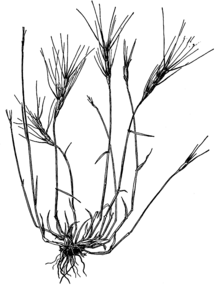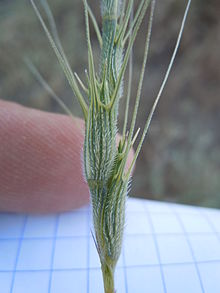
Herbicides, also commonly known as weed killers, are substances used to control undesired plants, also known as weeds. Selective herbicides control specific weed species while leaving the desired crop relatively unharmed, while non-selective herbicides kill plants indiscriminately. The combined effects of herbicides, nitrogen fertilizer, and improved cultivars has increased yields of major crops by 3x to 6x from 1900 to 2000.

Weed control is a type of pest control, which attempts to stop or reduce growth of weeds, especially noxious weeds, with the aim of reducing their competition with desired flora and fauna including domesticated plants and livestock, and in natural settings preventing non native species competing with native species.

Mesquite is a common name for several plants in the genus Prosopis, which contains over 40 species of small leguminous trees. They are native to dry areas in the Americas. They have extremely long roots to seek water from very far under ground. As a legume, mesquites are one of the few sources of fixed nitrogen in the desert habitat. The trees bloom from spring to summer. They often produce fruits known as "pods". Prosopis spp. are able to grow up to 8 metres (26 ft) tall, depending on site and climate. They are deciduous and depending on location and rainfall have either deep or shallow roots. Prosopis is considered long-lived because of the low mortality rate after the dicotyledonous stage and juveniles are also able to survive in conditions with low light and drought. The Cahuilla indigenous people of western North America were known to eat the seeds of mesquite.

Bromus tectorum, known as downy brome, drooping brome or cheatgrass, is a winter annual grass native to Europe, southwestern Asia, and northern Africa, but has become invasive in many other areas. It now is present in most of Europe, southern Russia, Japan, South Africa, Australia, New Zealand, Iceland, Greenland, North America and western Central Asia. In the eastern US B. tectorum is common along roadsides and as a crop weed, but usually does not dominate an ecosystem. It has become a dominant species in the Intermountain West and parts of Canada, and displays especially invasive behavior in the sagebrush steppe ecosystems where it has been listed as noxious weed. B. tectorum often enters the site in an area that has been disturbed, and then quickly expands into the surrounding area through its rapid growth and prolific seed production.

Centaurea diffusa, also known as diffuse knapweed, white knapweed or tumble knapweed, is a member of the genus Centaurea in the family Asteraceae. This species is common throughout western North America but is not actually native to the North American continent, but to the eastern Mediterranean.

Cortaderia selloana is a species of flowering plant in the Poaceae family. It is referred to by the common name pampas grass, and is native to southern South America, including the Pampas region after which it is named. It is widely distributed throughout the world as a cultivated ornamental and an invasive species.

Elymus repens, commonly known as couch grass, is a very common perennial species of grass native to most of Europe, Asia, the Arctic biome, and northwest Africa. It has been brought into other mild northern climates for forage or erosion control, but is often considered a weed.
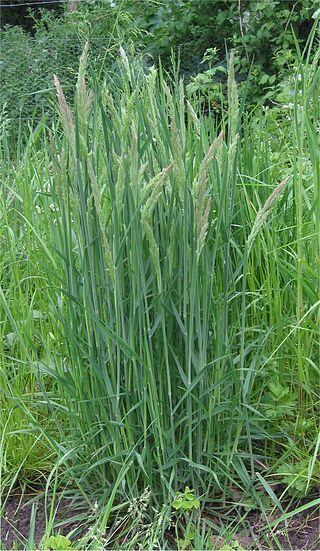
Holcus lanatus is a perennial flowering plant in the grass family Poaceae. The specific epithet lanatus is Latin for 'woolly' which describes the plant's hairy texture. Common names include Yorkshire fog, tufted grass, and meadow soft grass. In North America, where it is an invasive species, names include velvet grass and common velvet grass.
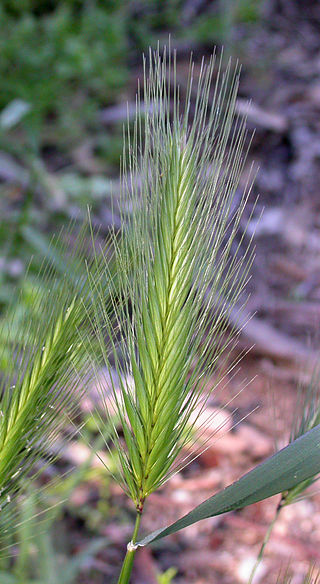
A foxtail is a spikelet or cluster of a grass, that serves to disperse its seeds as a unit. Thus, the foxtail is a type of diaspore or plant dispersal unit. Some grasses that produce a foxtail are themselves called "foxtail", also "spear grass". They can become a health hazard for dogs, cats, and other domestic animals, and a nuisance for people.

Aegilops is a genus of Eurasian and North American plants in the grass family, Poaceae. They are known generally as goatgrasses. Some species are known as invasive weeds in parts of North America.
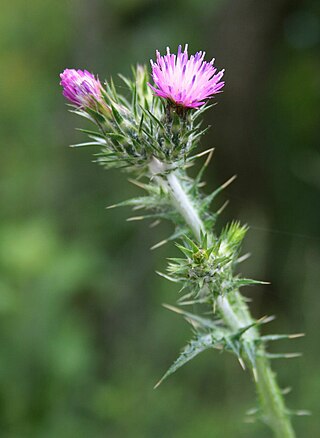
Carduus pycnocephalus, with common names including Italian thistle, Italian plumeless thistle, and Plymouth thistle, is a species of thistle. It is native to the Mediterranean region in southern Europe, North Africa, and Western Asia; Eastern Europe and the Caucasus; and the Indian Subcontinent.

Hordeum jubatum, with common names foxtail barley, bobtail barley, squirreltail barley, and intermediate barley, is a perennial plant species in the grass family Poaceae. It occurs wild mainly in northern North America and adjacent northeastern Siberia. However, as it escaped often from gardens it can be found worldwide in areas with temperate to warm climates, and is considered a weed in many countries. The species is a polyploid and originated via hybridization of an East Asian Hordeum species with a close but extinct relative of Californian H. brachyantherum. It is grown as an ornamental plant for its attractive inflorescences and when done flowering for its inflorescence.

Aegilops cylindrica, also known as jointed goatgrass, is an annual grass seed native to Southern Europe and Russia that is part of the tribe Triticeae, along with wheat and some other cereals. It is not native to North America, however it has become a serious issue as a weed since it was introduced in the late 19th century. Due to its relation to winter wheat, it is very difficult to control. Not only are the grains similar in shape and size to the seeds of winter wheat, making it difficult to remove through grain cleaning methods, the shared genetics mean that no registered herbicides are available to single out jointed goatgrass while leaving winter wheat unharmed. This poses problems for farmers who have to suffer through reduced yields and poorer quality winter wheat.

Agropyron cristatum, the crested wheat grass, crested wheatgrass, fairway crested wheat grass, is a species in the family Poaceae. This plant is often used as forage and erosion control. It is well known as a widespread introduced species on the prairies of the United States and Canada.

Bromus hordeaceus, the soft brome, is an annual or biennial species of grass in the grass family (Poaceae). It is also known in North America as bull grass, soft cheat, and soft chess.

Bromus diandrus is a species of grass known by the common names great brome and "ripgut brome".

Taeniatherum is a genus of Eurasian and North African plants in the grass family.
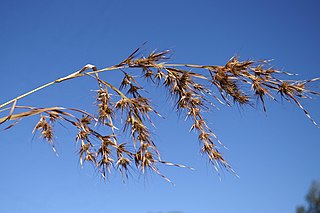
Themeda quadrivalvis is a species of grass known by the common names grader grass, habana grass, and kangaroo grass, not to be confused with Themeda triandra, which is also known as kangaroo grass. It is native to India, Nepal, and Malaysia. It can also be found in many other places as an introduced species and often a noxious weed. It occurs in the United States, New Caledonia, Fiji, Mauritius, Thailand, Indonesia, Papua New Guinea, China, the Middle East and tropical America. It is a troublesome exotic weed in Australia, especially in northern regions. It is also an agricultural weed in crops such as sugar cane and lucerne.
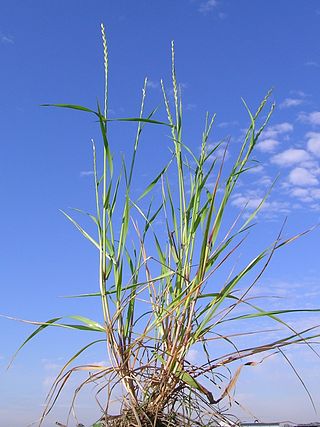
Lolium rigidum is a species of annual grass. Common names by which it is known include annual ryegrass, a name also given to Italian ryegrass, rigid ryegrass, stiff darnel, Swiss ryegrass and Wimmera ryegrass. It is a native of southern Europe, northern Africa, the Middle East and the Indian subcontinent and is grown as a forage crop, particularly in Australia, where it is also a serious and economically damaging crop weed.
Annual grasslands are a type of grassland ecosystem characterized by the dominance of annual grasses and forbs. They are most commonly found in regions with Mediterranean climates, such as California, and provide important habitats for a variety of wildlife species.

